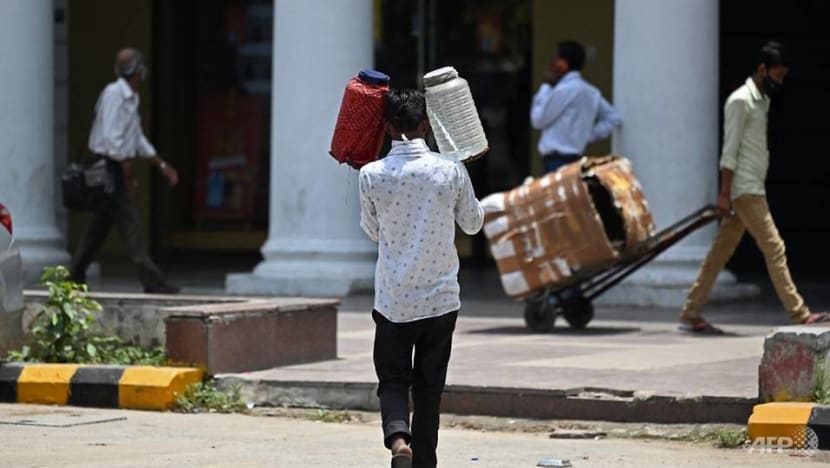Too hot to work: How India is tackling the growing threat of climate change
India's New Delhi saw its hottest July day in 90 years last month, with the temperature hitting 43.6 degrees Celsius. Money Mind finds out why it might become too hot to work in South Asia – and what businesses are doing to beat the heat.

A vendor carries plastic water containers along the roadside in New Delhi on Jul 5, 2021. (Photo: AFP/Sajjad Hussain)
SINGAPORE: On Jul 1 2021, the temperature hit 43.6 degrees Celsius in New Delhi – the hottest July day in 90 years.
It is the sort of heat where it is too hot to be outside, let alone work outdoors.
This is just one indicator of how India and South Asia will see some of the harshest consequences of a warming planet.
According to a report by consulting firm McKinsey, by 2050, between US$2.8 trillion and US$4.7 trillion of Asia’s annual GDP could be at risk due to extreme heat and humidity.
Much of the impact will be felt in South Asia, where an estimated 600 to 700 million people will have their livelihoods affected, because of the loss of outdoor working hours.
"In construction, in mining, in agriculture. These are outdoors activities so many people are at risk," said Mr Oliver Tonby, senior partner at McKinsey and McKinsey in Singapore.
"It's just simply going to get too hot to be outside, let alone too hot to work outside. If you sit in the shade for more than four hours in these extreme events, there's a risk that you might die," said Mr Tonby.
ECONOMIC IMPACT
The mean temperature across India has risen by 0.6 degree Celsius over the past century.
While that is slower than the 1 degree Celsius global average, the economic impact has been significant.
The impact will be even more severe, if temperatures rise beyond 2 degrees Celsius, said experts.
“Some districts have warmed faster than others. And those that have warmed the fastest have seen their gross domestic product or GDP grow on average by 56 per cent less than those that have warmed the slowest," said Ms Sarah Colenbrander, director of climate and sustainability at the Overseas Development Institute in London (ODI).
"If you look at falling agricultural productivity, sea level rise, and the increased money people would have to spend on health, those estimates meant that GDP or gross domestic product in 2100 would be reduced by about 10 per cent if we hit three degrees of warming. If we hit four degrees of warming, it would be 13.4 per cent a year.”
In a worst-case scenario, India’s GDP could fall be 90 per cent lower in in 2100 than it would have been without climate change, according to a report by the ODI, if weather patterns collapse due to warming oceans, melting Himalayan glaciers, and destruction of coral reefs.

READ: Up to 1 billion people in Asia to face lethal heatwave conditions by 2050 due to climate change: Report
BEATING THE HEAT
As the world’s third largest emitter of greenhouse gases after China and the US, India has set out a 40 per cent target for clean energy power generation and capacity by 2030.
Its goal includes a 33 per cent to 35 per cent reduction in emission intensity of GDP by the next decade.
But with rising incomes, increased population and economic growth, India’s energy demand and carbon footprint are only set to rise.
For now, the need to shift away from coal, the upgrading of informal settlements, social protection and change in working hours during hot and humid months are potential solutions.
Since 2013, more than 23 Indian states and about 100 cities have drafted heat action plans that set out guidelines on dealing with extreme temperatures.
READ: Abnormal temperatures responsible for 2.6 million deaths in Asia every year, global study finds
The Natural Resources Defense Council (NRDC) has been working with local governments to include installation of heat-proofing roofs as part of these plans.
Most dark roofs reflect not more than 30 per cent of incoming sunlight. In comparison, a new white roof reflects about 70 per cent to 80 per cent.
Such cool roofs are made from materials that retain less heat, helping buildings stay cooler than traditional roofs.
Cool roofs can be implemented using reflective white paint, prefabricated membranes, reflective tiles or vegetation to create green roofs.
Cool roofs can lower indoor temperatures by as much as 5 degrees Celsius.
Ms Prima Madan, NRDC India's lead cooling consultant, explains how the impact adds up.
“An implementation study in Hyderabad found that whitening of previously black roofs led to an estimated decrease of about 11 to 12 kg of carbon dioxide per square metre of roof area in annual direct CO2 emissions from reduced energy use. For a country like India where less than 10 per cent of the population or households has air conditioning, access to affordable cooling is really a matter of survival for millions of people.”
READ: 2020 likely world's second-hottest year, UN says
Last year, a plan by the city of Ahmedabad to paint the roofs of 15,000 slum households and 1,000 municipal buildings was derailed due to the pandemic.
NRDC said scaling up the adoption of cool roofs remains a challenge mainly due to lack of awareness and availability of cool roofing materials.
The cost starts at about 20 rupees per square foot – or about US$0.27.
But Prima Madan said this is still a costly proposition for low-income households.
She is calling for more innovative solutions, both from civil society and the government.
Beyond cool roofs, heatwave mitigation could also start at one’s backyard by growing micro-forests on barren patches of land.

Mr Shubhendu Sharma is founder and director of Afforestt, a service provider for creating natural, maintenance-free native forests.
It uses the Miyawaki method – a technique pioneered by Japanese botanist Akira Miyawaki - which helps build dense, native forests in a short time period.
Natural vegetation can be grown in spaces as small as 5 sqm to 6 sqm.
Seedlings of trees native to that area are collected and germinated before they are planted in soil mixed with biomass.
Mr Shubhendu said that such multi-layered forests absorb 30 times more sunlight.
He is experiencing the cooling effect firsthand: Thanks to a 12 sqm micro-forest he planted in his own backyard in Bangalore, he no longer needs to turn on the fan.
The cost of growing micro-forests can start from US$10 per square metre to as high as US$100 per square metre.
For real estate developers, the inclusion of such forests allows them to sell properties at a premium.
And it is upsides like these that make sustainability an attractive proposition, particularly in the energy space, said experts.
"Temperatures on average are going to rise. It's locked-in, that is a sad reality," said Mr Tonby.
"Now we have technologies, we have corporate commitments, we have technology under development. You combine all of these things and that makes me an optimist that we actually can turn the tide on sustainability," he added.












